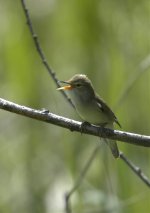I agree with all that its good to approach the definit ID of a Marsh Warber with caution.
I agree when someone says its good to be cautious, when assesing colours, as its possible that the colour of this bird are influenced by reflection of vegetation etc.
But when you assume that the colours are correct:
head and back in this bird are brown-grey with a green tinge.
The underparts are offwhite with a yellowish wash, and there is no brown on the flanks.
I know, Reed warblers without brownish wash to the flanks are frequent/regular, but the other colours?
I havent seen a Reed with the above mentioned colouration.(I havent seen a fuscus Reed yet):
So my question to more experiencend birders: have you seen a Reed Warbler with such a colouration before?
In other words: wouldnt you like a Marsh warbler to show such an IDfriendly colouration? Because in the majority of summer Marsh, the above mentioned (and in fieldguides) colours are not that evident. These birds are browner above and offwhite below and approach or are nearly identical to paler, less rufous Reeds.
Marsh with such greyish feet and darkish claws are rare, but I have seen some before.
I dont want to propose a new ID-feature, but: singing Reed warblers away from reeds in spring and summer normally do so hidden in vegetation, while Marsh are either hidden or quite open (but both very rarely exposed). Thats different to Reed warblers singing in reeds, where they regular sing open or exposed. Maybe this adds to the Marsh warbler feeling in this bird?
And last: arent you happy, that this bird has visible long undertail-coverts and a rounded tail, so a Hippolais-warbler can be excluded? I often say these words: imagine, this bird is a Reed warbler, would a Hippolais come in your mind, like in this bird?
conclusion: I hope to provoke some comments about the colouration as i am keen to learn! And I feel pity that this bird hasnt more normal colouration of feet and claws for a Marsh warbler. Because then I would say its an Idable Marsh.
For what its worth: here is a grey Reed warbler, taken near Angermünde, NE-Germany
https://flic.kr/s/aHskfmuWjM
Fading evening light adds to cold colours, but this was still a remarkable bird!






